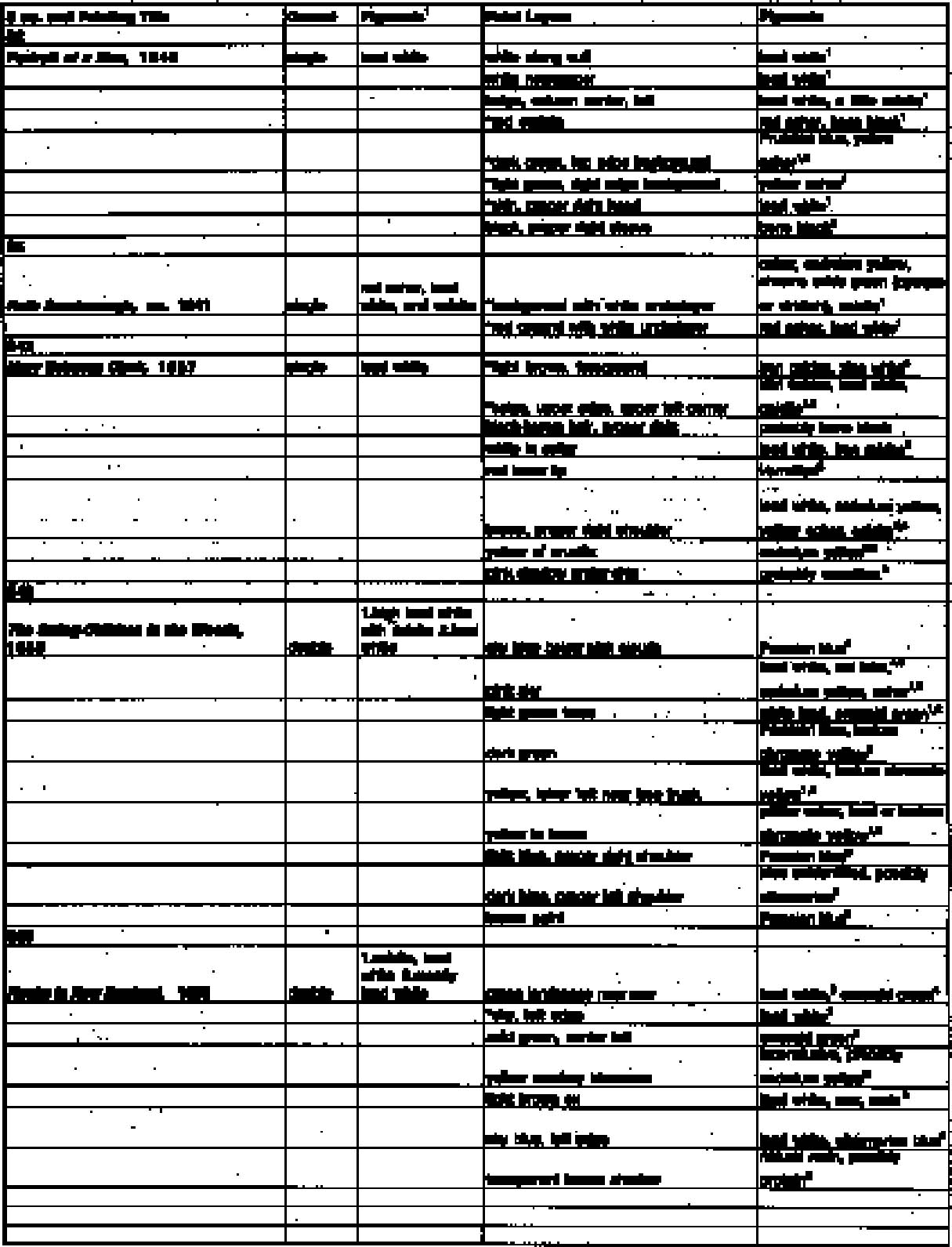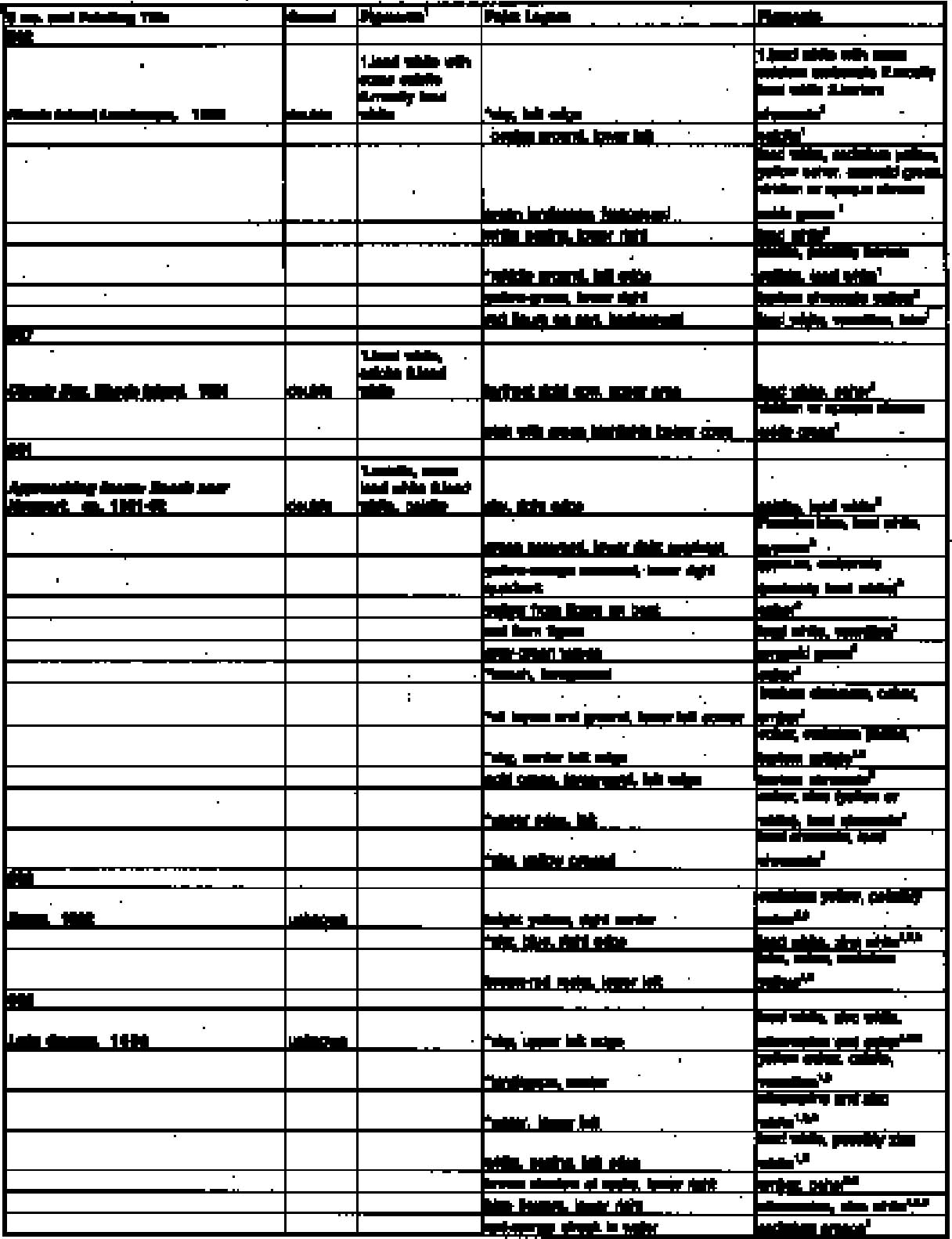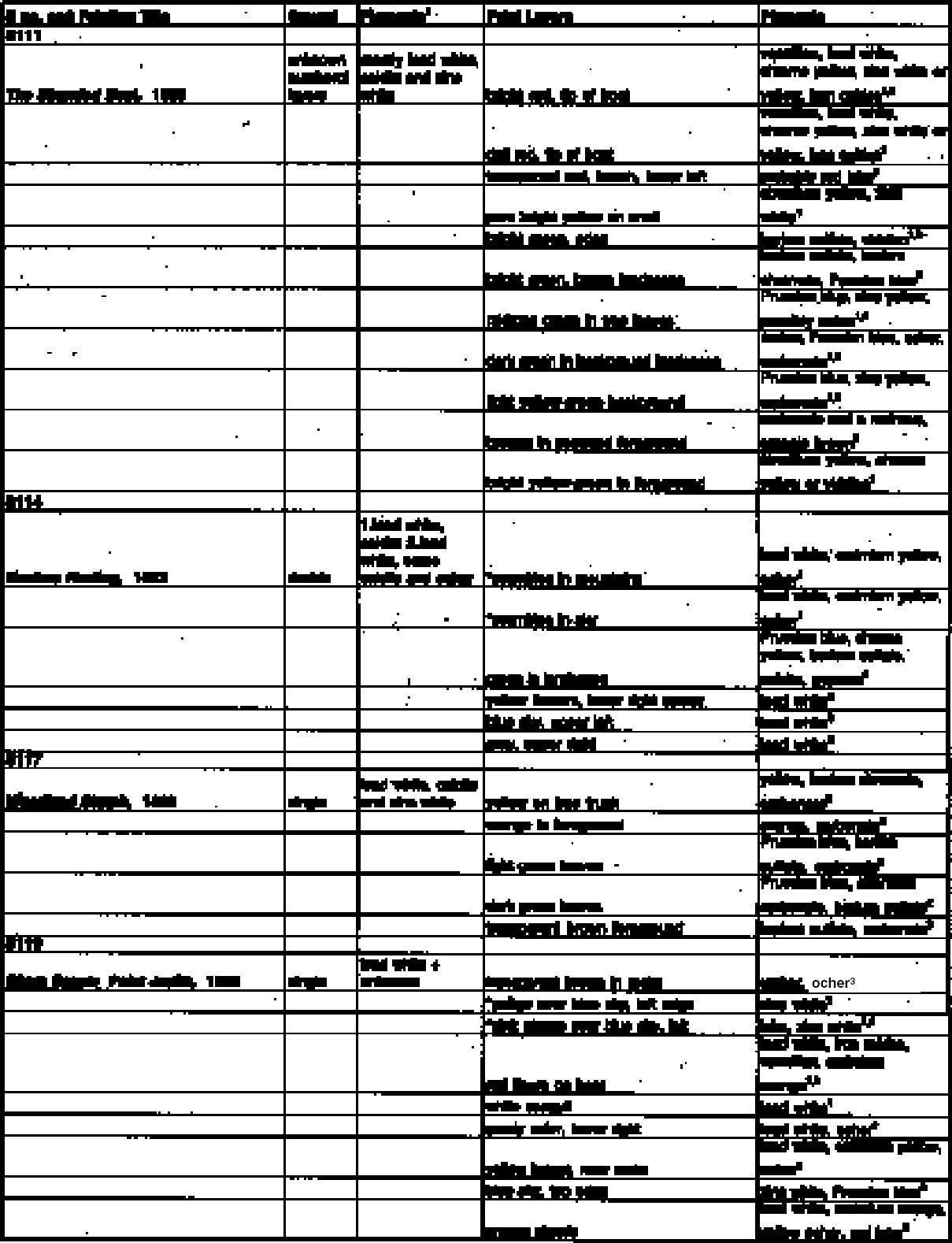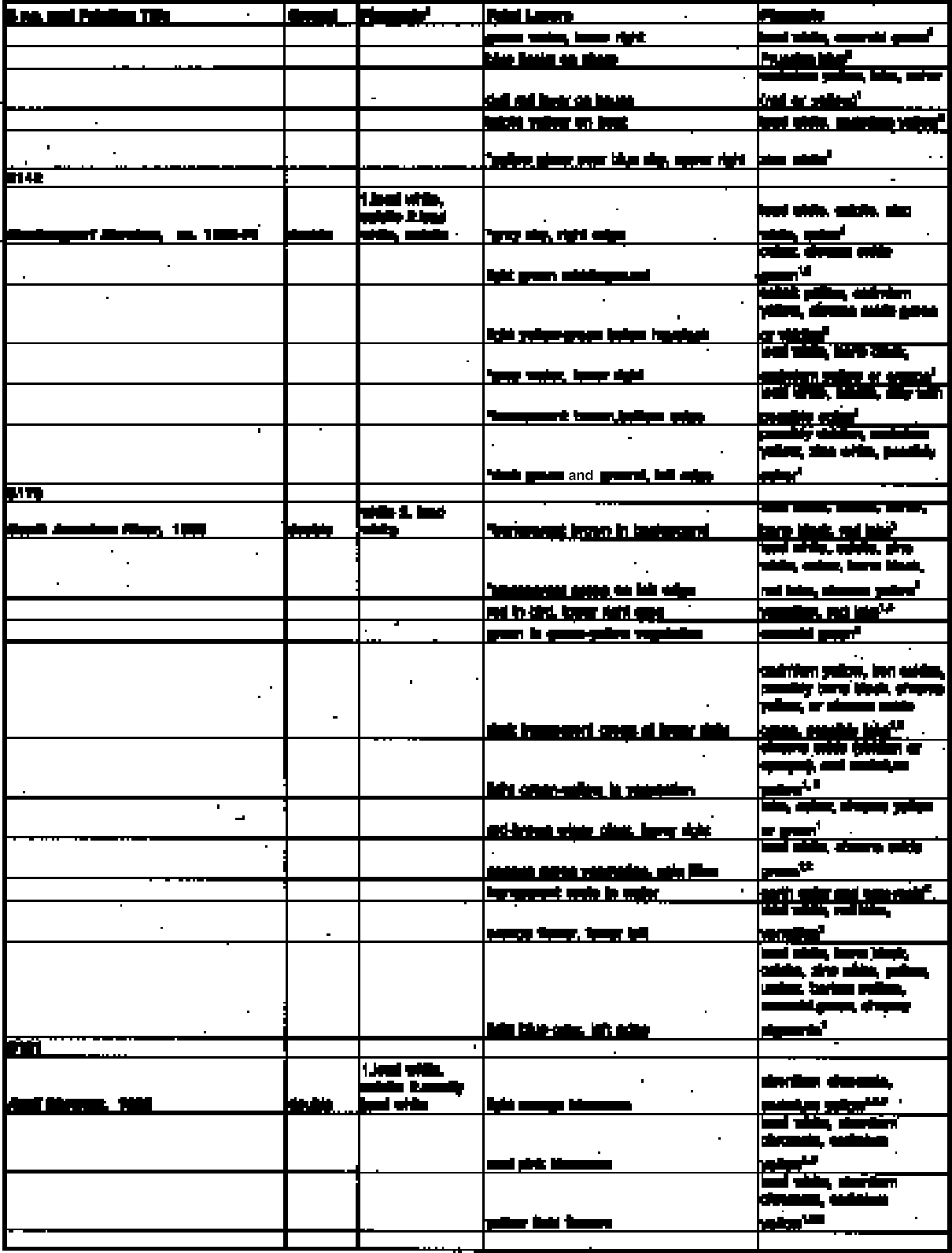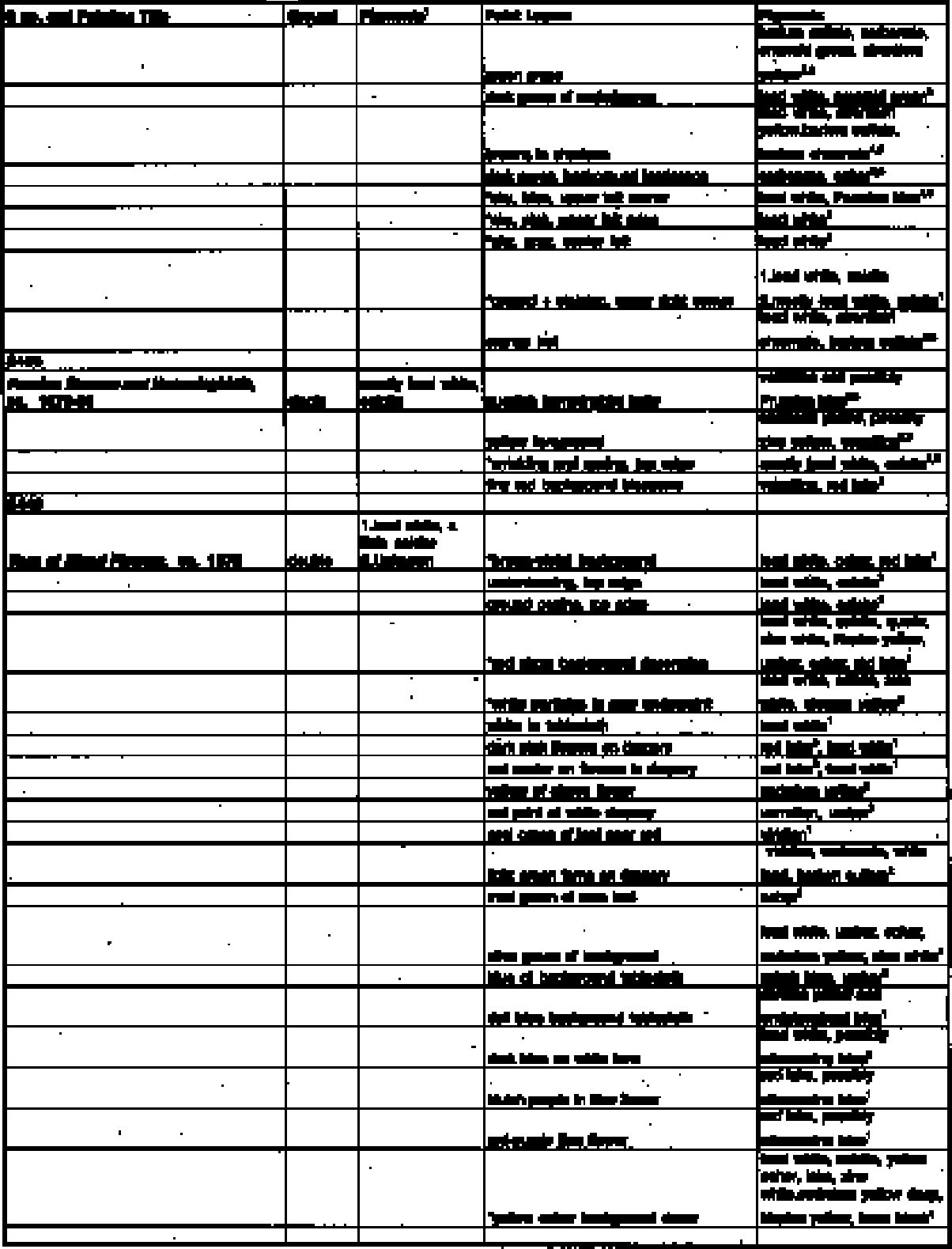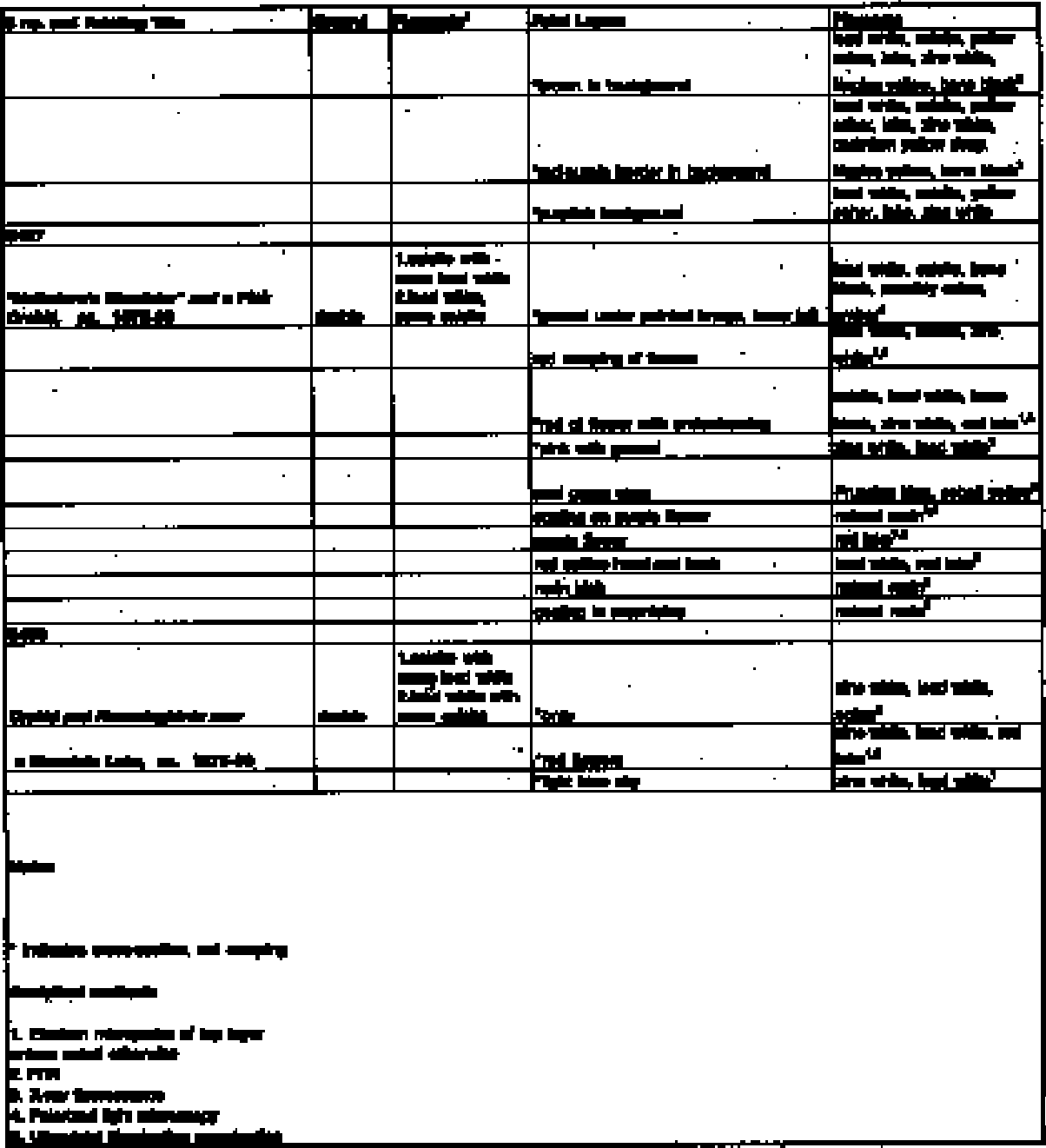THE METHODS AND MATERIALS OF MARTIN JOHNSON HEADEELIZABETH LETO FULTON
ACKNOWLEDGEMENTSThe authors would like to express their gratitude to the Samuel H. Kress Foundation for having largely funded this research project. The importance of working collaboratively with a team of experienced and knowledgeable conservators, scientists, and curators cannot go without mentioning. From the curatorial Department of Art in the Americas we thank former chair of American paintings Ted Stebbins, who has brought to the study 35 years of Heade expertise in addition to the exhibition catalog and catalogue raisonn�. Many thanks to Karen Quinn and Janet Comey, who were contributing authors to the exhibition catalog and brought their own unique and insightful perspectives to the study of Heade paintings. Additionally, we would like to thank Carol Troyen, curator of American paintings, for her contributions to the editing process. In the Conservation Division, we are grateful to conservation scientist Michele Derrick for her help in the analysis of pigments. Previous to this study, many of the paintings had been analyzed using x-ray fluorescence, an analytical technique performed largely by Kate Duffy with Richard Newman in 1993 at the Museum of Fine Arts, Boston. Also in the early 1990s at the MFA, Rita Albertson and others did seminal research into Heade's techniques, especially focusing on the oil sketches and their relation to finished paintings. We would like to acknowledge Leane Delgaizo, collections care specialist, and Andrew Haines, assistant conservator of frames, who were responsible for the transport and framing/unframing of the paintings in the study. We would also like to thank Rhona MacBeth for her technical help with infrared and computer imaging, and Devi Ormond, a visiting paintings conservation intern who assisted in the technical research. We are also grateful to Arthur Beale, chair of conservation and collections management at the MFA, Boston, for his support. NOTES1. The “S” number refers to the catalog number in Stebbins 2000. APPENDIXAPPENDIX 1: PAINTINGS EXAMINED
APPENDIX 2: ANALYTICAL TECHNIQUES FOR PIGMENT IDENTIFICATIONThe techniques utilized for pigment identification in this project were nondestructive energy dispersive x-ray fluorescence (XRF), electron probe microanalysis (EPMA), Fourier transform infrared microspectroscopy (FTIR), and polarizing light microscopy (PLM). Nondestructive XRF was used to survey different brightly colored areas of many of the paintings. The custom-built instrument consists of an Ortec Si(Li) detector operated by a HNU System 5000 spectrometer; a 1 mm collimated x-radiography tube (continuum tungsten radiation) is utilized as the excitation source. The XRF system can detect calcium and all heavier elements in the periodic table and is a valuable tool in helping to identify many inorganic pigments. It rarely provides definitive pigment identification, however, since many elements detected can point to more than one specific pigment. Small scrapings were taken from the paintings in order to provide more detailed information on the pigments, and it is these results that are reported in this article and the summary table (appendix 3). A portion of each sample was pressed between the diamond windows of a Spectra Tech “Micro Sample Plan.” One or both of the windows, with adhered sample, were studied by PLM to note the number of different types of pigments present. The PLM permitted some inorganic pigments to be identified with confidence and the presence of organic pigments (such as red lakes) to be noted. The pressed sample was then analyzed by FTIR microspectroscopy utilizing a Nicolet 510P FTIR spectrometer with an attached NicPlan IR microscope. The microscope apertures were adjusted to frame analysis areas that varied from about 20 μm across to 60 μm across. Generally, several areas in each pressed sample were analyzed, with areas containing different individual pigment particles or clusters of particles being chosen. Specific identifications of organic and inorganic compounds are based on comparison of the FTIR spectra with several commercial databases and in-house libraries. FTIR analysis can readily establish the presence of many different kinds of polyatomic anions (such as sulfate, carbonate, and chromate) and can provide specific identifications of individual compounds within these classes. In the case of carbonates, for example, calcite, cerussite (present in many lead whites), hydrocerussite (also found in many lead whites), and numerous others can be positively identified, either alone or in mixtures. To name one other example, the different chromate-containing yellow pigments (zinc, barium, lead, and strontium) can also be distinguished on the basis of their FTIR spectra (an excellent general reference to the utilization of IR spectroscopy for inorganic compound identification is Farmer 1974). However, some pigments do not have IR spectra, for example, the cadmium colors, vermilion, and zinc white. To supplement the FTIR data and provide important elemental information on pigments that do not have IR spectra, a second portion of many of the paint scrapings was analyzed by qualitative energy dispersive x-ray fluorescence in a Cameca MBX electron beam microprobe (Department of Earth and Planetary Sciences, Harvard University). In some cases, cross sections were prepared, and the micro-probe analyses were carried out on these. This instrument can detect sodium and all higher elements. Individual pigment particles as small as a few μm can easily be visualized by back-scattered electron imaging and then analyzed in the instrument. Finally, some dispersed pigment slides were also prepared in Cargille Meltmount and examined by PLM. These slides were superior to the samples pressed on the diamond window for careful micro-scopic examination, and they also provide a permanent record of the sample. The combination of procedures outlined here, sometimes supplemented by powder x-ray diffraction, It should be noted that, although not discussed here, the FTIR analyses also provide basic information on the paint media. In this study, without exception, FTIR spectra indicated that Heade used oil paints. A more detailed study of the oil, and possible additives such as natural resins, would require chromatographic techniques, which we did not utilize for the research project reported here. APPENDIX 3: ANALYTICAL RESULTS
REFERENCESBlaugrund, A.1997. The Tenth Street Studio Building: Artist-entrepreneurs from the Hudson River School to the American Impressionists. Southampton, N. Y.: Parrish Art Museum. J. G.Chapman. 1847. American drawing book: A manual for the amateur, and basis of study for the professional artist: Especially adapted to the use of public and private schools, as well as home instruction. New York: J. S. Redfield. Durand, A. B.1855. Letters on landscape paintings: Letter 1. Crayon1, no. 6 (Jan. 3):1. Farmer, V. C., ed.1974. The infrared spectra of minerals. London: Mineralogical Society. Ferber, L. S., and W. H.Gerdts. 1985. The new path: Ruskin and the American Pre-Raphaelites. Brooklyn, N. Y.: Brooklyn Museum and Schocken Books. Ruskin, J. [1857], and B.Dunstan. 1991. The elements of drawing, illustrated edition with notes by Bernard Dunstan,ed. B.Dunstan. New York: Watson-Guptill Publications. Sheldon, L.1998. Methods and materials of the PreRaphaelite circle in the 1850s. Painting techniques: History, materials and studio practice. Contributions to the Dublin Congress. Dublin: IIC. Stebbins, T. E.1975. The life and work of Martin Johnson Heade. New Haven: Yale University Press. Stebbins, T. E.2000. The life and work of Martin Johnson Heade. New Haven: Yale University Press. Wright, J.1999. The development of Martin Johnson Heade's painting technique. In T. E. Stebbins, Martin Johnson Heade. Boston: Museum of Fine Arts. 169–83. Zucker, J.1999. From the ground up: The ground in 19th-century American pictures. Journal of the American Institute for Conservation38:3–20. FURTHER READINGBomford, D., J.Kirby, J.Leighton, and A.Roy. 1990. Art in the making: Impressionism. London: National Gallery Publications Limited. Cash, S.1994. Ominous hush: The thunderstorm paintings of Martin Johnson Heade. Fort Worth, Texas: Amon Carter Museum. Feller, R. L., and R. M.Johnson-Feller. 1997. Vandyke brown. In Artists' pigments: A handbook of their history and characteristics, Vol. 3, ed. E. W.FitzHugh. Washington, D. C.: National Gallery of Art. 157–90. Fiedler, I., and M.Bayard. 1997. Emerald green and Scheele's green. In Artists' pigments: A handbook of their history and characteristics, Vol. 3, ed. E. W.FitzHugh. Washington, D. C.: National Gallery of Art. 219–71. Gettens, R. J., and G. L.Stout. 1966. Painting materials: A short encyclopaedia. New York: Dover Publications. K�hn, H., and M.Curran. 1986. Chrome yellow and other chromate pigments. In Artists' pigments: A handbook of their history and characteristics, Vol. 1, ed. R. L.Feller. Washington, D. C.: National Gallery of Art. 187–217. Newman, R.1997. Chromium oxide greens: Chromium oxide and hydrated chromium oxide. In Artists' pigments: A handbook of their history and characteristics, Vol. 3, ed. E. W.FitzHugh. Washington, D. C.: National Gallery of Art. 273–93. Plesters, J.1993. Ultramarine blue, natural and artificial. In Artists' pigments: A handbook of their history and characteristics, Vol. 2, ed. A.Roy. Washington, D. C.: National Gallery of Art. 37–65.
Stebbins, T. E.1999. Martin Johnson Heade. Boston: Museum of Fine Arts. AUTHOR INFORMATIONELIZABETH LETO FULTON is an associate conservator of paintings at the Museum of Fine Arts, Boston, and she also works part-time in private practice. She was assistant conservator of paintings at the Isabella Stewart Gardner Museum from 1996 to 2001. She has a B.A. in Italian studies, with emphasis in art history, from the University of Connecticut, 1985, and an M.A. and a certificate of advanced study in art conservation from the State University of New York, College at Buffalo, 1994. She started her conservation training in Florence, Italy, where she received certificates from the Universita' Inter-nazionale dell' Arte and the Associazione Fiorentina, 1986. She has completed postgraduate internships in paintings conservation at the National Gallery of Art, Washington, D.C., 1995, and Straus Center for Conservation at Harvard University Art Museums, 1994, and she has worked as a student intern at the Wadsworth Atheneum in Hartford, Connecticut, 1993, the Phillips Collection in Washington, D.C., 1992, and Yale University Art Gallery in New Haven, Connecticut, 1990–91. Address: Paintings Conservation, Museum of Fine Arts, Boston, 465 Huntington Ave., Boston, Mass. 02115. RICHARD NEWMAN is head of scientific research at the Museum of Fine Arts, Boston. He has a B.A. in art history from Western Washington University, 1974, and an M.A. in geology from Boston University, 1983. He received a certificate for completion of a three-year apprenticeship, specializing in conservation science, at the Center for Conservation and Technical Studies, Fogg Art Museum, Harvard University, 1980. He worked as both a conservation scientist and assistant conservator of sculpture and objects at the Fogg Art Museum from 1980 to 1986, and since 1986 he has worked at the Museum of Fine Arts, Boston. Address as for Fulton. JEAN WOODWARD is an associate conservator of paintings at the Museum of Fine Arts, Boston, where she has been on the staff since 1975 (working under Elizabeth Jones, 1975–79, and under Alain Goldrach, 1980–87). She has worked extensively on both European and American paintings. In the American paintings collection she has studied or treated in depth many 18th-and 19th-century paintings and has been involved with the Heade project since its inception in 1992. She has a B.A. in art history from Goucher College, 1961, and she completed the three-year apprenticeship program in conservation, specializing in paintings conservation, at the Fogg Art Museum, Harvard University, in 1964. Address as for Fulton. JIM WRIGHT is the Eyk and Rose-Marie van Otterloo Conservator of Paintings at the Museum of Fine Arts, Boston, and head of paintings conservation, 1992 to present. He was conservator of paintings at the Fine Arts Museum of San Francisco from 1987 to 1991 (head of paintings conservation, 1989–91) and held various conservation positions at the San Francisco Museum of Modern Art in San Francisco from 1982 to 1987 (intern, assistant conservator, and associate conservator). He received a B.A. in art history and philosophy from Saint Louis University, 1977, and an M.A. and certificate of advanced study from the State University of New York, College at Oneonta, New York (Cooperstown Graduate Program in Conservation), 1983. Address as for Fulton. |
